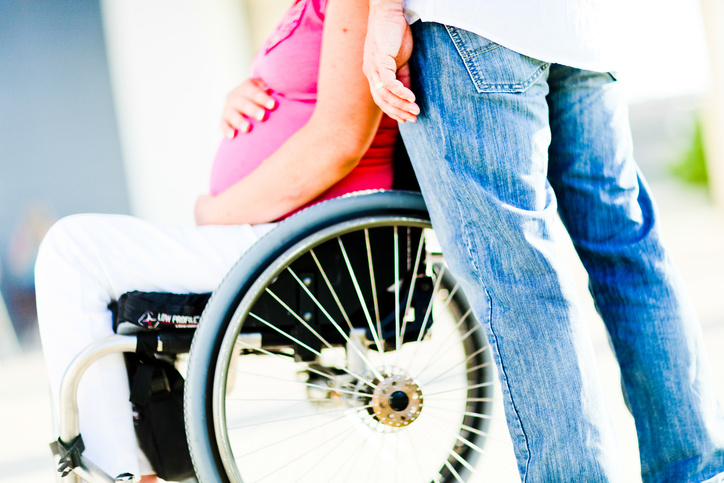Adaptive Parenting Strategies Used by Mothers with Physical Disabilities Caring for Infants and Toddlers
June 10, 2019

Introduction
People with disabilities are increasingly likely to choose parenthood as society moves toward fostering their full inclusion. Furthermore, women with physical disabilities have similar rates of pregnancy to their non-disabled counterparts. While there has been an increasing body of research on mothers with disabilities and their needs, there is comparatively scant research on these mothers’ experiences of early motherhood.
In this study, we wanted to find out how mothers with physical disabilities in the United States use adaptive parenting strategies to care for their babies and toddlers, and any potential barriers to using those strategies they may encounter. Mothers with physical disabilities often contend with inaccessible providers’ offices, clinicians and social workers with minimal training on parenting and disability, and stigma and stereotyping about their decision to have children. They also struggle to find support with breastfeeding, postpartum planning, and other childcare skills that account for their specific needs.
Findings and Next Steps
Our interviewees had the following characteristics:
- The average age of the participants was 32.
- Most participants were non-Hispanic white, married, and had college or graduate degrees.
- A slight majority used mobility aids like wheelchairs and canes.
- Fourteen mothers had only one child, while 11 had more than one. Two participants were pregnant.
- A majority of participants had planned pregnancies.
- Participants’ youngest children’s ages ranged from less than 1 to 10 years old.
- Mothers had a wide variety of disabilities, including dwarfism, muscular dystrophy, osteogenesis imperfecta, cerebral palsy, stroke, multiple sclerosis, and spina bifida.
- Seven participants had at least one child with a disability.
Five broad themes about adaptive parenting emerged from this study: finding or modifying accessible baby-care equipment, home modifications and adaptations, accessing support and information, learning how to communicate in ways that ensured both their and their children’s safety, and receiving help from others.
Most participants used adaptive baby-care equipment. For example, some parents used cribs designed specifically for parents with disabilities, custom-made cribs, while others modified traditional cribs to suit their needs. One interviewee altered a crib to have two doors that swing open, since she wasn’t able to lift her infant daughter out of the crib otherwise.
Participants modified their homes to be more accessible to their parenting needs through a variety of methods: ensuring that baby-care equipment and supplies were in strategic locations, using alternative methods to dress their children, and installing accessible kitchen appliances. These strategies were often ingenious: one mother “flipped an Ikea bookcase on the side to use as a changing table and storage,” and another placed a changing pad on a bookshelf.
Though most of the participants in this study had college educations and higher incomes—unlike the majority of mothers with physical disabilities—many of them still found adaptive parenting equipment prohibitively expensive.
Mothers with disabilities knew that finding advice, information, and support was crucial to raising their children successfully. Some used online communities to find peer support, like Facebook groups, while others connected to national disability organizations to find other parents with similar experiences. That said, however, many participants had difficulty finding information on childcare that addressed their disabilities. Mainstream parenting books rarely discussed the intersection between disability and parenting. Participants found general-purpose parenting forums similarly wanting; one mother said that she felt unwelcome and that “disabled moms were often isolated.” Even the occupational therapists some participants worked with were not well equipped to help them develop the skills they needed to care for their children.
Participants also had to develop communication strategies to compensate for their disabilities and ensure that their children were safe. For example, some mothers taught their children to always be within their range of vision to make sure that children didn’t wander off into the street or other areas that were unsafe.
Finally, some participants needed to access physical supports from their partners, extended families, or personal assistants to take care of their children, including help with cooking, laundry, cleaning, burping, and lifting their babies in and out of the bathtub. Some mothers encountered barriers to accessing the supports they needed. One mother had to pay for a supporter, but said she would not be able to afford long-term care. Some other participants received publicly funded personal care assistant (PCA) services, but PCAs were explicitly disallowed from helping them with parenting tasks.
Our findings have salient implications for healthcare, social work, and public policy. We suggest that policymakers and program directors take the following steps to support mothers with physical disabilities:
- Increase financial support for adaptive baby-care equipment and home modifications,
- Provide more comprehensive training on parenting with a disability for service providers and policymakers,
- Facilitate stronger peer networks for parents with disabilities, and
- Expand publicly funded PCA services to cover childcare needs
Credit
Adapted by Finn Gardiner, from Robyn Powell, Monika Mitra, Suzanne Smeltzer, Linda Long-Bellil, Lauren Smith, Eliana Rosenthal, and Lisa Iezzoni (2018). Adaptive parenting strategies used by mothers with physical disabilities caring for infants and toddlers. Health and Social Care in the Community, 2018; 1-10. DOI: 10.1111/hsc.12706
